The Regina Alpine Adaptive Ski Program believes that all people have an equal right to participate in Alpine Skiing regardless of ability.
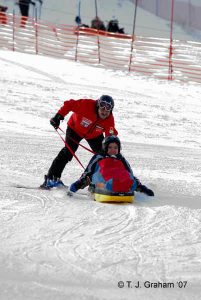
The Regina Adaptive Ski Program has adaptive ski equipment for various types of disabilities. We offer lessons to individuals with cerebral palsy, spina bifida, spinal cord injuries, multiple sclerosis, muscular dystrophy, visual impairment, and lower extremity amputations that can wear a prosthetic which supports some body weight.
Our program has instructors with specialized training and certification through the Canadian Association for Disabled Skiing (CADS) with Level 1, Level 2, and Level 3 Certifications.
Training days will be held at Mission Ridge Winter Park at Fort Qu’Appelle, Sask.
Mission Ridge has added many features to make their facility handicapped accessible, such as: accessible washroom, ramps, an elevator, carpet lifts and a chair lift.
2023-24 Program Days
| Date | Event | Location | Cost – Contact |
| Dec 10-17 | Para Camp | Silver Star, BC | extra cost – Gord Poulton |
| Jan 13 | Training Day | Mission Ridge | included in membership fee |
| Jan 20 | Training Day | Mission Ridge | included in membership fee |
| Feb 3 | Training Day | Mission Ridge | included in membership fee |
| Feb 10 | SaskTel Challenge Cup | Mission Ridge | included in membership fee |
| Mar 2 | Training Day | Mission Ridge | included in membership fee |
| Mar 16 | Training Day / Races | Mission Ridge | included in membership fee |
| Mar 23 | Asessippi Trip | Asessippi Ski, MB | extra cost – Luc Lemoine |
Cost of the program (6 days at Mission Ridge) is $150 for the season.
All participants must be Regina Ski Club members and CADS members.
Contact Us:
For further information, contact: Gord Poulton or Carrie Darin or Luc Lemoine at [email protected]
Adaptive Ski Techniques and Equipment
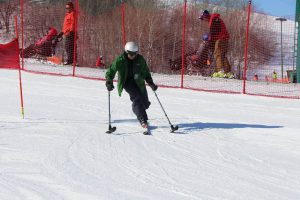 Outriggers:
Outriggers:
Adapted crutches with forearm and hand contact points.
The ends of the pole have ski tips.
- Walk mode
- Ski mode
Outriggers are used for balance, mobility and turning for both walking and skiing.
Three-tracking:
Some disabilities that are common for individuals using this adaptive equipment are individuals with an amputation in the longer leg (commonly seen above knee), individual’s with post-polio condition, individual’s with developmental or muscular disease affecting one leg, individual’s who had a stroke with impairment in one side of lower limbs, and individual’s with acquired brain injury.
Individuals with one strong leg and two strong supporting arms. Amputation is above knee, when a prosthetic cannot be used, due to no control over ski angle on snow use a standard alpine ski and two outriggers, adjusted to individual’s height. Balance is increased by having three points of contact on the snow. An individual learning how to three-track must keep their ski very flat on the snow to provide the ability to pivot the ski. A more advanced three-tracker will learn how to carve the ski through a turn.
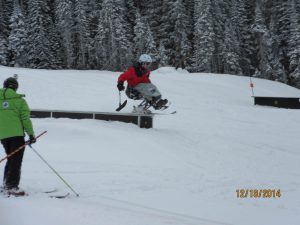 Four-Tracking:
Four-Tracking:
Some disabilities that are common for individuals using this adaptive equipment are individuals with cerebral palsy, spina bifida, spinal cord injuries, multiple sclerosis, muscular dystrophy, and lower extremity amputations that can wear a prosthetic which supports some body weight. Encompasses individual’s with mobility impairment that require a walker or cane for stability.
Skier uses two standard alpine ski and two outriggers to support the weight of the body. The skier initiates turns by steering the outriggers in the direction causing rotation of the body, which then drives the feet and skis in the direction of the turn. Skis must remain flat against the surface of the snow in order to pivot in the direction of the turn.
Outriggers assist with lateral control and balance Snow Slider Walker Skiers requiring upper-body or whole-body stabilization, and use for individuals with less arm strength than a four tracker would have. It is lightweight, diverse, steerable stand-up aid Full range of steering and speed control adjustments In this ski frame, ski can be adjusted to form a snowplow configuration or a straight running as depicted. Turning is accomplished by the individual transferring weight onto the downhill ski and rotating the ski frame with the upper body. This ski frame does not allow for ski to be placed on edge during the turn. This unit requires volunteers to tether the skier to help initiate the turn and provide speed control. This adaptive ski equipment encompasses individuals that are unable to stand for prolonged periods of time Bi-Skiing
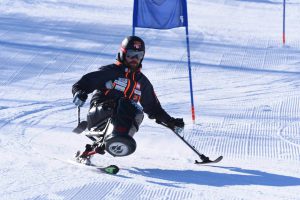 Mono-Ski:
Mono-Ski:
Some disabilities that are common for individuals using this adaptive equipment are individuals with cerebral palsy, brain injuries, multiple sclerosis, muscular dystrophy, spina bifida, spinal cord injury and amputations. Seat is mounted to two shorter, wider, heavily side cut skis. The seat can be made out many materials including, fiber-glass, and plastic. The seat must be snug fitting, as it acts as the individuals ski boot, transferring steering and weight transfer to the skis. Skier can ski independently or tethered with an instructor. Provides more stability than mono-ski Skier gains balance by the use of shorter outriggers. The outriggers also act as an aid in initiating the turn, as well providing mobility in flat surfaces. Fixed outriggers can be attached to the base of the bi-ski to provide increased stability with individuals with less balance. With this particular set-up an Instructor must be tethered to bi-skier Mono-skiing. Some disabilities that are common for individuals using this adaptive equipment are individuals with Double leg Amputations, Lower level spinal cord injuries, Spina bifida, Multiple sclerosis, Muscular dystrophy, and Cerebral palsy. Mono-ski techniques are very similar to three-tracking, with having the three points of contact for balance, and only using one standard alpine ski. Seat is mounted to a single ski and use hand-held outriggers, much the same as bi-skier. The seat is made from plastic or fiberglass and must fit snuggle to skier as it acts a ski boot to transfer steering and weight transfer to the ski, the same as the bi-ski. The difference between mono-skiing and bi-skiing is that Mono-ski requires the greatest amount of balance and strength to operate.
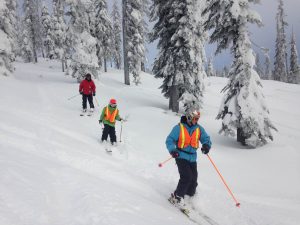 Blind Skiing:
Blind Skiing:
Individuals with a visual impairment of any degree, ranging from total blindness to partial impairment of vision Ski guide directs the individual on terrain and turning distance by either voice and/or radio communication but no physical contact is allowed in competition. In competition the ski guide can ski ahead or behind depending on the classification of the skier.
Volunteer your time:
- Support people with disabilities
- Improve independence to skiers
- Improve quality of life for skiers
- Canadian Association of Disabled Skiing Training






